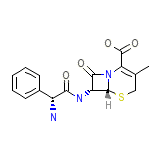Syncl




Categoria
Syncl Nombres de marca, Syncl Analogos
- Alcephin
- Alexin
- Alsporin
- Biocef
- CEX
- Carnosporin
- Cefa-iskia
- Cefablan
- Cefadal
- Cefadin
- Cefadina
- Cefaleksin
- Cefalessina [DCIT]
- Cefalexin
- Cefalexin (JP14)
- Cefalexin Sodium
- Cefalexina [INN-Spanish]
- Cefalexine [INN-French]
- Cefalexinum [INN-Latin]
- Cefalin
- Cefaloto
- Cefaseptin
- Cefax
- Ceforal
- Cefovit
- Celexin
- Cepastar
- Cepexin
- Cephacillin
- Cephalexin (USP)
- Cephalexin (free base)
- Cephalexin 1-hydrate
- Cephalexin hydrate
- Cephalexin monohydrate
- Cephalexine
- Cephalexinum
- Cephanasten
- Cephaxin
- Cephin
- Cepol
- Ceporex
- Ceporex Forte
- Ceporexin
- Ceporexin-E
- Ceporexine
- Check
- Cophalexin
- Durantel
- Durantel DS
- Ed A-Ceph
- Erocetin
- Factagard
- Felexin
- Fexin
- Ibilex
- Ibrexin
- Inphalex
- Kefalospes
- Keflet
- Keflex
- Kefolan
- Keforal
- Keftab
- Kekrinal
- Kidolex
- L-Keflex
- Lafarine
- Larixin
- Lenocef
- Lexibiotico
- Lonflex
- Lopilexin
- Madlexin
- Mamalexin
- Mamlexin
- Medoxine
- Neokef
- Neolexina
- Novolexin
- Nufex
- Oracef
- Oriphex
- Oroxin
- Ortisporina
- Ospexin
- Palitrex
- Panixine Disperdose
- Pectril
- Pyassan
- Roceph
- Roceph Distab
- Sanaxin
- Sartosona
- Sencephalin
- Sepexin
- Servispor
- Sialexin
- Sinthecillin
- Sporicef
- Sporidex
- Syncl
- Syncle
- Synecl
- Tepaxin
- Tokiolexin
- Uphalexin
- Voxxim
- Winlex
- Zozarine
Syncl Marca los nombres de mezcla
Syncl Formula quimica
C16H17N3O4S
Syncl RX enlace
http://www.rxlist.com/cgi/generic/cephalex.htm
Syncl FDA hoja
Syncl MSDS (hoja de seguridad de materiales)
Syncl Sintesis de referencia
RB Morin, BG Jackson, EE.UU. Pat. 3.275.626.861 (1966,1970)
Syncl Peso molecular
347.39 g/mol
Syncl Punto de fusion
326.8oC
Syncl H2O Solubilidad
1789 mg / L
Syncl Estado
Solid
Syncl LogP
0.019
Syncl Formas de dosificacion
Cápsulas (que contiene monohidrato de cefalexina equivalente a 250 mg o 500 mg de cefalexina); Tablet (que contiene monohidrato de cefalexina equivalente a 250 mg o 500 mg de cefalexina), la suspensión
Syncl Indicacion
Para el tratamiento de infecciones del tracto respiratorio causadas por Streptococcus pneumoniae y Streptococcus pyogenes, la otitis media causada por Streptococcus pneumoniae, Haemophilus influenzae, Staphylococcus aureus, Streptococcus pyogenes y Moraxella catarrhalis, infecciones de piel y estructura de la piel causadas por Staphylococcus aureus y / o Streptococcus pyogenes, infecciones óseas causadas por Staphylococcus aureus y / o Proteus mirabilis, las infecciones del tracto genitourinario, incluyendo prostatitis aguda, causada por Escherichia coli, Proteus mirabilis y Klebsiella pneumoniae.
Syncl Farmacologia
Cefalexina (también llamado cefalexina) es un antibiótico de cefalosporina de primera generación. Es uno de los antibióticos más recetados, a menudo usados para el tratamiento de infecciones superficiales que resultan como las complicaciones de las heridas o laceraciones leves. Es eficaz contra la mayoría de bacterias gram-positivas.
Syncl Absorcion
Bien absorbido desde el tracto gastrointestinal
Syncl Toxicidad
Los síntomas de sobredosis incluyen sangre en la orina, diarrea, náuseas, dolor abdominal, y vómitos. La dosis oral letal media de la cefalexina en ratas es> 5000 mg / kg.
Syncl Informacion de Pacientes
Patients should be counseled that antibacterial drugs including Keflex should only be used to treat bacterial infections. They do not treat viral infections (e.g., the common cold). When Keflex is prescribed to treat a bacterial infection, patients should be told that although it is common to feel better early in the course of therapy, the medication should be taken exactly as directed. Skipping doses or not completing the full course of therapy may (1) decrease the effectiveness of the immediate treatment and (2) increase the likelihood that bacteria will develop resistance and will not be treatable by Keflex or other antibacterial drugs in the future.
Syncl Organismos afectados
Bacterias entéricas y otras eubacterias














